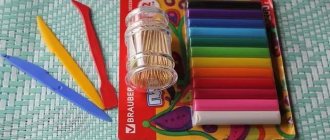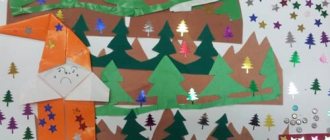Short-term project in the middle group “Magic lids”
Short term project
"Magic Caps"
in the middle group
The project was prepared and implemented by teacher A.A. Polyakova. and children of the middle group
Problem
:
Environmental problems have attracted the attention of the entire society. Plastic waste is difficult to recycle. Specific examples of human use of plastic bottles and caps, the consequences of this impact (when burned, they emit toxic gases) on nature, human health and the environment can be adopted by teachers in order to develop a healthy lifestyle in children. The brightness and mystery of the material is very suitable for the needs of children, for their expectation of a holiday from every day, a constant readiness to be surprised and rejoice. And to become a little bit of a researcher and experimenter ourselves...
Why do we need so many different types of lids? How can they be used and for what?
Motivation
:
Everything in the world is undergoing changes - a brand new toy has become a set of individual parts, and vice versa, parts turn into a new toy. A developing environment allows every child to find something they like and to believe in their strengths and abilities. .
Objective
of the project
:
Learn to see the results of labor, figure out how to use non-traditional, waste material - lids from different containers.
To create conditions for the development of imagination and to promote the intellectual creative self-development of children, the integrated use of pedagogical technologies in the educational process to familiarize preschoolers with lids.
Develop cognitive activity, curiosity, creativity, imagination, thinking, communication skills, improve the quality of activities in your free time.
Encourage children's experimentation and research skills.
Tasks
:
- Determine the ways and methods of developing the creative, cognitive, and intellectual abilities of children.
- To create a unified space that develops an educational and intellectual environment in a kindergarten, stimulating the cognitive activity of children.
- To determine the content of original educational games for the development of children’s creative intellectual abilities, to clarify and expand knowledge about lids and to form a conscious understanding of their significance.
- Develop a system of active cooperation between children, parents and educators in this direction.
Object of study:
Lids, their purpose, the materials from which they are made, use.
Subject of study:
Development of general cognitive abilities of preschoolers and teachers.
Research
hypothesis :
People will always need lids to close vessels and containers.
Implementation
period :
Short term, creative project over 4 weeks.
Project participants
: Children, parents, teachers.
System
of project activities
- Studying the theoretical and methodological foundations of preparing a child for the formation of interaction with the outside world.
- Convince project participants that intellectual, creative, artistic, and technical capabilities are realized with the help of this material.
- Select methodological, popular science literature, toys, illustration material, attributes for play activities on this issue, material for visual and productive activities.
Project implementation stages
PREPARATORY STAGE
- selection of literature on a given topic
- Conversations with children at home and in kindergarten about the purpose of lids. A selection of material about them.
- Drawing up an announcement for parents.
- production of didactic games.
- Reading fiction about magic, transformations, etc. (“Wheels” by V. Suteev and others)
- Parents and children did homework: looked at lids, illustrations, pictures.
- Drawing and coloring stencils with pencils, exhibition of children's creativity.
MAINSTAGE.
- Children, while playing, should be introduced to the properties of lids through games, experiences and experiments.
"Drowning - not drowning."
"Signets."
"Wonderful chest."
“Collect according to description, color and sample.”
Relay game “Collect a flower”.
- Conduct a series of activities and didactic games: “Gather a bouquet”, “Decorate a napkin”, “What’s extra?”, “Create your own picture”, “Mosaic”, “Balloons”;
- Examination of illustrations depicting various types of lids, making an album with various compositions, involving children in discussion on issues.
- Searching, preparing and memorizing poems, riddles, tongue twisters about transformations, magic, etc.
THE FINAL STAGE.
- Final lesson “These lids are sorceresses.”
Project presentation
- Generalization of experience in developing intellectual and sensory abilities in preschool children.
- Preparation of material for presentations in preschool educational institutions and for publication in print media.
Stages of experimentation
.
Exploring the secrets of lids.
1. Take a magnifying glass and look at it. What do we see? We discovered many different small depressions and bends, the existence of which the children did not even suspect. We saw many different drawings and patterns in an enlarged state
2. Take a scale and weigh two lids that are identical and two that are different in shape and size. We see that the weight varies depending on the size.
3. Water the lids from a watering can (as if it had rained). Invite the children to touch them again and examine them. What happened? Children press their fingertips on the surface - the lids have become wet.
4. Lower the lids into a container of water. What do we notice? They swim, but some drown. Why? (have weight or the void is filled with water). We notice that during sinking they gurgle and a characteristic sound is heard (this is air coming out). Pulling them out of the water, we note that they have become slippery.
5. Slope of the board. Lids are the same size, but made of different materials (plastic, tin, foil, etc.). Release the covers along the slope at the same time and observe. The lid that reaches the floor first has the least friction compared to others.
Then we decided to put a lot of lids on this plastic board and see what came out of it. Since the board is plastic and thin, it began to sag more and more, the more covers were placed on it.
6. Pendulum. They made a hole in the lid, threaded it, pushed it to swing the pendulum and see how many times it swings. Then we shortened the thread and again observed the number of oscillations (increased and they became more frequent).
Let's attach plasticine to the lids and see what has changed: the weight of the lid, the tension of the thread, and the amplitude of the pendulum have changed. Compare, draw a conclusion.
7. Add gouache of different colors to the foam rubber. Using the “stamp” method, apply several multi-colored circles onto white or colored cardboard and you get an interesting, fabulous, magical design. You can finish the resulting drawings with a brush.
8. We tried to make maracas from plastic and iron caps and checked how they sounded. The iron ones sound loud, the plastic ones sound muffled.
9. Kind caps to help orphans We learned that there is a campaign to collect plastic bottle caps for a good cause. If you collect about 8 tons of plastic (that's 1 truck), you can get the necessary amount for a wheelchair for a child. In total, this is 4 million caps (1 kg is about 500 pieces), the price of one cap is 7 kopecks, and 1 ton of plastic is about 25 thousand rubles. The collected caps will be sent to the EcoTechnology recycling plant, and the money for the recycled materials will be transferred to a charitable foundation.
Why are caps collected and not whole bottles?
Collecting and storing caps is easier and more enjoyable than collecting bottles. In addition, the plastic must be returned clean, and it is much easier to wash the cap than the bottle. Bottles take up more space than caps and are much more expensive to store and transport. The cost of the cap is almost the same as that of the bottle.
The movement to collect caps in favor of charitable organizations (not only in Russia, but also abroad) is a fairly common practice. Containers for collecting caps are installed in large supermarkets, educational institutions, sports centers, cafes and restaurants, gas stations, police and municipal structures, etc.
The popularity of the “lid” movement is ensured by the fact that it is a simple and unpretentious gesture that costs a person nothing, and at the same time helps both the environment and people in need - for prosthetics, wheelchairs, expensive treatment, etc.
You can create many different games and crafts with lids
Conclusion: Lids come in different types, densities, weights, they sink and float, they can be warm and cold, hard and soft, smooth and rough, of different colors and sizes. The lids can be used to draw on cardboard and paper. Play with them and use them in educational and board games. And also collecting plastic caps is a charity event.
There are special containers for recycling plastic products.
List of used literature:
1. Davydova G.N. Crafts from waste materials (issue 3). – M.: Publishing house: “Scriptorium 2003”, 2006.
2. Davydova G.N. Crafts from waste materials. Flowers. - M.: Publishing house "Scriptorium 2003", 2008.
3. L.D. Komarova. Didactic and logic games with colored caps.
Publisher: Detstvo-Press, 2007.
4. E. Polozova: Developmental simulators made from waste material
Publisher: IP Lakotsenina, 2009
5. “Philanthropist” - Electronic magazine about charity. The article “Lids of the World: How Ordinary Trash Turns into Good Deeds.”
https://philanthropy.ru/analysis/2017/02/16/46356/

